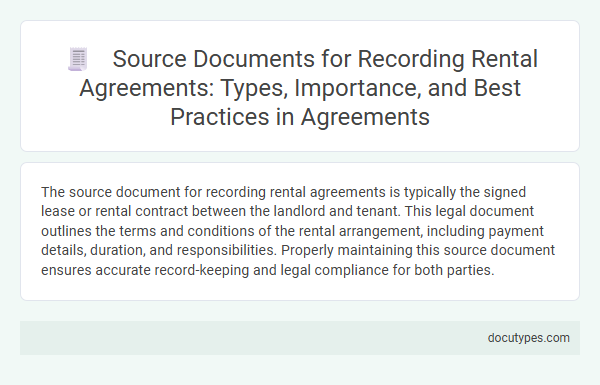The source document for recording rental agreements is typically the signed lease or rental contract between the landlord and tenant. This legal document outlines the terms and conditions of the rental arrangement, including payment details, duration, and responsibilities. Properly maintaining this source document ensures accurate record-keeping and legal compliance for both parties.
Introduction to Source Documents in Rental Agreements
Source documents serve as the original records for all rental agreements, capturing essential details such as tenant information, rental terms, and payment conditions. These documents provide the foundational data required for accurate lease recording and ensure legal compliance throughout the rental process. Understanding the importance of your rental agreement source document helps maintain clear and organized property management records.
Types of Source Documents Used in Rental Transactions
The source document for recording rental agreements is essential for accurate financial and legal records. It provides the primary evidence of the terms and conditions agreed upon by the landlord and tenant.
Common types of source documents used in rental transactions include lease agreements, rent receipts, and payment vouchers. Lease agreements outline the duration, rent amount, and obligations of both parties. Rent receipts serve as proof of payment, while payment vouchers track rental income in accounting systems.
Key Components of a Rental Agreement Document
What is the source document for recording rental agreements? The source document is the rental agreement itself, which details the terms and conditions agreed upon by both landlord and tenant. This document serves as the official record for all rental transactions.
What are the key components of a rental agreement document? Essential components include the names of the parties involved, property address, rental term, payment details, and responsibilities of both landlord and tenant. Clear definitions of maintenance obligations and termination procedures are also critical for legal clarity.
Why is it important to refer to the original rental agreement? Your rental agreement provides the definitive evidence needed to resolve disputes and enforce the contract's provisions. Accurate record-keeping based on this document helps protect the rights of all parties involved.
Importance of Accurate Source Documentation in Agreements
The source document for recording rental agreements typically includes the signed lease contract between the landlord and tenant. Accurate source documentation ensures all terms are clearly verified and legally binding, reducing disputes and facilitating proper record-keeping.
- Verification of Terms - Source documents confirm rental amounts, duration, and conditions agreed upon by both parties.
- Legal Evidence - Proper documentation serves as admissible proof in case of litigation or enforcement of agreement terms.
- Financial Accuracy - Accurate records enable precise rent tracking and accounting for both landlords and tenants.
Legal Implications of Incomplete or Missing Documents
| Topic | Details |
|---|---|
| Source Document for Recording Rental Agreements | The primary source document for recording rental agreements is the signed lease or rental contract between the landlord and tenant. This document outlines the terms, conditions, rent amount, duration, and responsibilities of both parties. |
| Legal Implications of Incomplete Documents | Incomplete rental agreements can lead to disputes over terms such as rent, maintenance responsibilities, and lease duration. Courts may find it difficult to enforce rights and obligations if key elements of the agreement are missing or ambiguous. |
| Legal Implications of Missing Documents | The absence of a written rental agreement may result in reliance on verbal agreements or statutory landlord-tenant laws, which may not reflect the intentions of the parties involved. This increases the risk of legal conflicts and potential financial losses. |
| Importance of Proper Documentation | Accurate and complete rental agreements serve as crucial legal evidence in case of disputes, support the enforcement of tenant and landlord rights, and provide clarity and security for both parties throughout the rental period. |
Best Practices for Creating and Storing Rental Source Documents
The source document for recording rental agreements is the original signed lease contract between the landlord and tenant. Proper creation and storage of these documents ensure legal compliance and facilitate easy reference during tenant disputes or audits.
- Create Clear, Detailed Agreements - Draft rental agreements with precise terms including rent amount, duration, and responsibilities for both parties.
- Use Digital and Physical Storage - Store copies of rental agreements both digitally, using encrypted cloud storage, and physically in organized files for redundancy.
- Maintain Accessibility and Security - Ensure rental source documents are stored in a secure location accessible only to authorized personnel to protect sensitive information.
Digital vs. Physical Source Documents: Pros and Cons
The source document for recording rental agreements can be either digital files or physical paper contracts. Digital source documents offer advantages such as easy storage, quick retrieval, and enhanced sharing capabilities, while physical documents provide a tangible record and may be preferred for legal authenticity. Each format has drawbacks; digital files risk data loss or hacking, whereas physical documents require secure storage and can be prone to damage or misplacement.
Common Mistakes in Recording Rental Agreements
The source document for recording rental agreements is the signed lease or rental contract between the landlord and tenant. This agreement outlines the terms, payment schedules, and responsibilities of both parties.
Common mistakes in recording rental agreements include failing to capture all essential clauses and neglecting to update records when amendments occur. You should always ensure accurate and complete documentation to avoid disputes and legal issues.
Verification and Authentication of Source Documents
The source document for recording rental agreements is typically the signed lease contract between the landlord and tenant. This document serves as the primary evidence of the terms and conditions agreed upon by both parties.
Verification of the source document involves checking the signatures, dates, and completeness of the agreement to ensure authenticity. Authentication may include notarization or witness signatures to confirm that your rental agreement is legally binding and genuine.
What Is the Source Document for Recording Rental Agreements? Infographic

